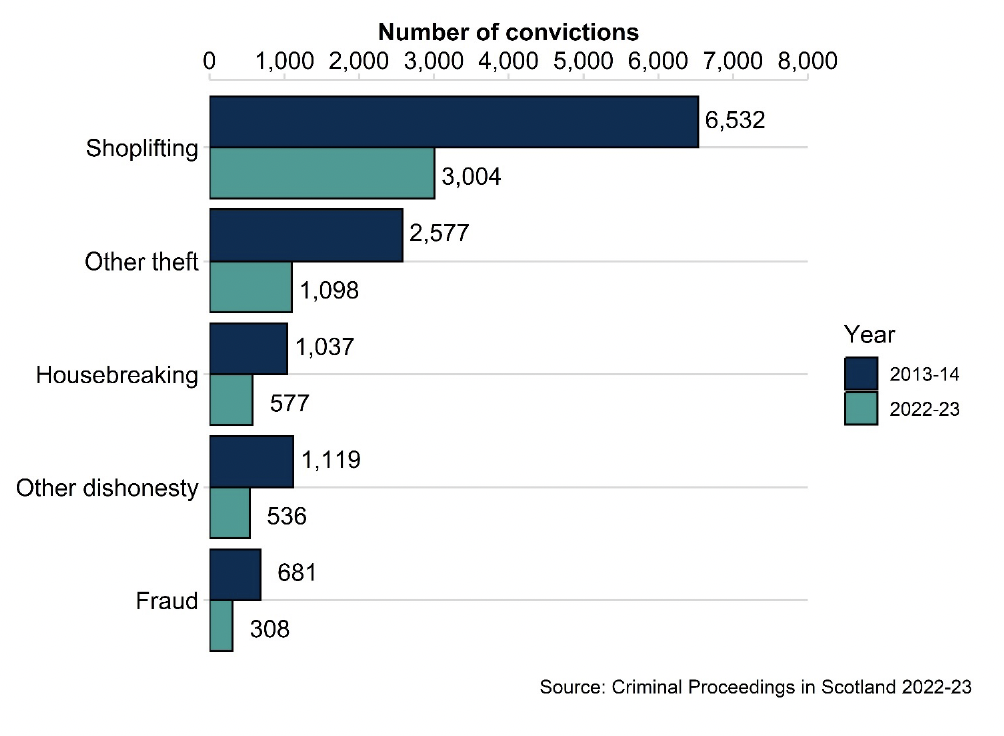Criminal Proceedings in Scotland, 2022-23
Statistics on criminal proceedings concluded in Scottish courts and alternative measures to prosecution issued by the police and the Crown Office and Procurator Fiscal Service are presented for the 10 years from 2013-14 to 2022-23.
5. People convicted by crime or offence
(Tables 4a and 4b)
Breaches of criminal law can be divided into ‘crimes’ and ‘offences’. This distinction is made only for statistical reporting purposes. Although the breaches allocated under “crimes” can generally be considered to be more serious, there are some “offences” that have more severe punishments associated with them than “crimes”.
The Scottish Government has recently introduced a new classification of crimes and offences following a consultation in response to user needs. The full paper Presenting official statistics on recorded crime and related topics: consultation provides users with more information on background to the consultation and the new grouping structure for the presentation of crime statistics section provides a full breakdown of the new classification structure. The biggest change is the transfer of Common assault and Stalking from the Miscellaneous offences group to the Non-sexual crimes of violence group.
High-level summary
People convicted by crime or offence group
(Tables 4a-b and 6a-b)
- In 2022-23, 53% of all breaches were crimes and 47% were offences
Year on year change (2021-22 to 2022-23)
Crimes:
- Between 2021-22 and 2022-23, convictions for crimes increased by 15%
- Non-sexual violence convictions increased by 2,068 (23%)
- Crimes against society convictions increased by 1,627 (13%)
- Crimes of dishonesty convictions increased by 451 (8%)
- Damage and reckless behaviour convictions increased by 246 (17%)
- Sexual crimes convictions increased by 132 (10%)
Offences:
- Between 2021-22 and 2022-23, convictions for offences increased by 14%
- Road traffic offences increased by 2,509 (13%)
- Antisocial offences increased by 1,448 (15%)
- Miscellaneous offences increased by 261 (22%)
Change over the latest 10 years (2013-14 to 2022-23)
Crimes:
- Between 2013-14 and 2022-23, convictions for crimes decreased by 36%
- Non-sexual violence convictions decreased by 2,083 (16%)
- Crimes against society convictions decreased by 4,387 (24%)
- Crimes of dishonesty convictions decreased by 6,650 (53%)
- Damage and reckless behaviour convictions decreased by 775 (31%)
- Sexual crimes convictions increased by 286 (25%)
Offences:
- Between 2013-14 and 2022-23, convictions for offences decreased by 41%
- Road traffic offences decreased by 18,766 (47%)
- Antisocial offences decreased by 3,810 (26%)
- Miscellaneous offences decreased by 1,452 (50%)
Breakdown by age and sex
- In 2022-23, males accounted for 81% (8,976) of convictions for Non-sexual crimes of violence and 95% of convictions for sexual crimes (1,346).
- In 2022-23, those age over 40 were the largest age group convicted for sexual crimes, (44% or 629 convictions) and road traffic offences (36% or 7,786 convictions). Those aged 31-40 were the largest age group of those convicted for crimes of dishonesty (40% or 2,360 convictions)
Key points to note
- Within sexual crime, the number of people convicted of a main charge of Rape and attempted rape was 187 in 2022-23. This is the highest total since comparable records began in 1989 and is an increase of 17% on 2021-22 (160 people) and an increase of 108% on 2013-14 (90 people). The conviction rate for Rape and attempted rape fluctuates year to year and was 54% in 2022-23. This is the second highest rate in the 10-year span.
- The number of people convicted of a main charge of a crime of dishonesty in 2022-23 was 5,929. This is an increase of 8% on 2021-22 (5,478 people) and a decrease of 53% on 2013-14 (12,579 people).
Please note that recording delays are typical for high court activity due to the complex nature of cases held there. As a result the number of proceedings and convictions for Rape and attempted rape for 2021-22 may be slightly underestimated. More information is available in the Annex B revisions section.
Chart 6. Longer term trends in Rape and attempted rape and Sexual assault convictions [Note 1] show general increases.
Rape and attempted rape and Sexual assault convictions in Scottish courts, 2013-14 to 2022-23.

Notes for Sexual crimes
Note 1. Although Sexual crimes includes more categories, for clarity Chart 6 is limited to just Rape and attempted rape and Sexual assault. These two categories both attract the highest proportion of custodial sentences and have the longest average custodial sentence length.
Chart 7. Convictions for Crimes of dishonesty have declined over the long term.
Comparison of convictions in Scottish courts for the most common types of Crimes of dishonesty, 2013-14 and 2022-23.

Contact
Email: justice_analysts@gov.scot
There is a problem
Thanks for your feedback